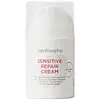What's inside
What's inside
 Key Ingredients
Key Ingredients

 Benefits
Benefits

 Concerns
Concerns

 Ingredients Side-by-side
Ingredients Side-by-side

Water
Skin ConditioningButyrospermum Parkii Butter
Skin ConditioningCaprylic/Capric Triglyceride
MaskingGlycerin
HumectantCanola Oil
EmollientCetearyl Alcohol
EmollientCetearyl Olivate
Helianthus Annuus Hybrid Oil
EmollientSorbitan Olivate
EmulsifyingAvena Sativa Kernel Oil
Skin ConditioningBetaine
HumectantGlyceryl Stearate
EmollientHydrolyzed Hyaluronic Acid
HumectantBeta-Glucan
Skin ConditioningTocopherol
AntioxidantXanthan Gum
EmulsifyingMaltodextrin
AbsorbentLevulinic Acid
PerfumingSodium Levulinate
Skin ConditioningCitric Acid
BufferingPhenoxyethanol
PreservativeSodium Benzoate
MaskingPotassium Sorbate
PreservativeWater, Butyrospermum Parkii Butter, Caprylic/Capric Triglyceride, Glycerin, Canola Oil, Cetearyl Alcohol, Cetearyl Olivate, Helianthus Annuus Hybrid Oil, Sorbitan Olivate, Avena Sativa Kernel Oil, Betaine, Glyceryl Stearate, Hydrolyzed Hyaluronic Acid, Beta-Glucan, Tocopherol, Xanthan Gum, Maltodextrin, Levulinic Acid, Sodium Levulinate, Citric Acid, Phenoxyethanol, Sodium Benzoate, Potassium Sorbate
Water
Skin ConditioningCaprylic/Capric Triglyceride
MaskingCoco-Caprylate/Caprate
EmollientCetyl Alcohol
EmollientGlycerin
HumectantStearyl Alcohol
EmollientCetearyl Olivate
Alcohol Denat.
AntimicrobialSorbitan Olivate
EmulsifyingPhenoxyethanol
PreservativeXanthan Gum
EmulsifyingCaprylyl Glycol
EmollientTocopheryl Acetate
AntioxidantAloe Barbadensis Leaf Juice Powder
Skin ConditioningTotarol
AntioxidantEthylhexylglycerin
Skin ConditioningEclipta Prostrata Extract
Skin ConditioningMelia Azadirachta Leaf Extract
Skin ConditioningMethylglucoside Phosphate
Skin ConditioningCopper Lysinate/Prolinate
Skin ConditioningHydroxypropyl Cyclodextrin
MaskingMoringa Oleifera Seed Extract
Skin ConditioningVaccinium Macrocarpon Fruit Extract
AstringentPalmitoyl Tripeptide-38
Skin ConditioningMaltodextrin
AbsorbentSyringa Vulgaris Leaf Cell Culture Extract
Skin ConditioningHamamelis Virginiana Extract
AntiseborrhoeicButylene Glycol
HumectantWater, Caprylic/Capric Triglyceride, Coco-Caprylate/Caprate, Cetyl Alcohol, Glycerin, Stearyl Alcohol, Cetearyl Olivate, Alcohol Denat., Sorbitan Olivate, Phenoxyethanol, Xanthan Gum, Caprylyl Glycol, Tocopheryl Acetate, Aloe Barbadensis Leaf Juice Powder, Totarol, Ethylhexylglycerin, Eclipta Prostrata Extract, Melia Azadirachta Leaf Extract, Methylglucoside Phosphate, Copper Lysinate/Prolinate, Hydroxypropyl Cyclodextrin, Moringa Oleifera Seed Extract, Vaccinium Macrocarpon Fruit Extract, Palmitoyl Tripeptide-38, Maltodextrin, Syringa Vulgaris Leaf Cell Culture Extract, Hamamelis Virginiana Extract, Butylene Glycol
Ingredients Explained
These ingredients are found in both products.
Ingredients higher up in an ingredient list are typically present in a larger amount.
This ingredient is an emollient, solvent, and texture enhancer. It is considered a skin-softener by helping the skin prevent moisture loss.
It helps thicken a product's formula and makes it easier to spread by dissolving clumping compounds.
Caprylic Triglyceride is made by combining glycerin with coconut oil, forming a clear liquid.
While there is an assumption Caprylic Triglyceride can clog pores due to it being derived from coconut oil, there is no research supporting this.
Learn more about Caprylic/Capric TriglycerideCetearyl Olivate is an emulsifier and texture enhancer. It is derived from the fatty acids of olive oil and Cetearyl alcohol, and is biodegradable.
As an emulsifier, it is used to prevent oils and waters from separating. It can also
Manufacturers use the name Olivem 1000. This ingredient has been found to preserve the natural microbiome of skin. Having a healthy microbiome helps keep our skin healthy and protects against harmful bacteria. This ingredient is grouped with Sorbitan Olivate under the name Olivem 1000.
Learn more about Cetearyl OlivateGlycerin is already naturally found in your skin. It helps moisturize and protect your skin.
A study from 2016 found glycerin to be more effective as a humectant than AHAs and hyaluronic acid.
As a humectant, it helps the skin stay hydrated by pulling moisture to your skin. The low molecular weight of glycerin allows it to pull moisture into the deeper layers of your skin.
Hydrated skin improves your skin barrier; Your skin barrier helps protect against irritants and bacteria.
Glycerin has also been found to have antimicrobial and antiviral properties. Due to these properties, glycerin is often used in wound and burn treatments.
In cosmetics, glycerin is usually derived from plants such as soybean or palm. However, it can also be sourced from animals, such as tallow or animal fat.
This ingredient is organic, colorless, odorless, and non-toxic.
Glycerin is the name for this ingredient in American English. British English uses Glycerol/Glycerine.
Learn more about GlycerinMaltodextrin is a polysaccharide. It is derived from starch such as rice, corn, wheat, or potato starch.
In food, Maltodextrin is used to improve the texture and thicken a product. Due to its structure, it can help create a gel texture. As an emulsion stabilizer, it helps keep the ingredients in a product together.
As a polysaccharide, Maltodextrin has moisturizing properties. Polysaccharides are a type of carbohydrate. The top layer of skin uses polysaccharides to retain water, keeping the skin hydrated.
Maltodextrin is water soluble and has a sweet taste.
Learn more about MaltodextrinPhenoxyethanol is a preservative that has germicide, antimicrobial, and aromatic properties. Studies show that phenoxyethanol can prevent microbial growth. By itself, it has a scent that is similar to that of a rose.
It's often used in formulations along with Caprylyl Glycol to preserve the shelf life of products.
Sorbitan Olivate is created from the fatty acids in olive oil and sorbitol.
This ingredient is an oil in water emulsifier. It helps stabilize a product by preventing oils and waters from separating. Sorbitan Olivate also helps hydrate the skin.
Manufacturers sell sorbitan olivate under the name OliveM 1000. OliveM 1000 a multifunctional ingredient. It is self-emulsifying. According to a manufacturer, OliveM 1000 does not disrupt natural skin biome.
Due to its olive oil base, this ingredient may not be fungal-acne safe.
Learn more about Sorbitan OlivateWater. It's the most common cosmetic ingredient of all. You'll usually see it at the top of ingredient lists, meaning that it makes up the largest part of the product.
So why is it so popular? Water most often acts as a solvent - this means that it helps dissolve other ingredients into the formulation.
You'll also recognize water as that liquid we all need to stay alive. If you see this, drink a glass of water. Stay hydrated!
Learn more about WaterXanthan gum is used as a stabilizer and thickener within cosmetic products. It helps give products a sticky, thick feeling - preventing them from being too runny.
On the technical side of things, xanthan gum is a polysaccharide - a combination consisting of multiple sugar molecules bonded together.
Xanthan gum is a pretty common and great ingredient. It is a natural, non-toxic, non-irritating ingredient that is also commonly used in food products.
Learn more about Xanthan Gum